Analysing the Influence on Health and Social Care Organisations
VerifiedAdded on 2020/02/12
|14
|4381
|85
Report
AI Summary
This report examines the impact of organizational structures and culture on health and social care services, specifically focusing on the Voluntary Service Overseas (VSO) organization. It begins by comparing and contrasting different organizational structures such as functional, matrix, and geographical structures, discussing their advantages and disadvantages in the context of health and social care. The report then explores the concept of organizational culture, including power, role, task, and person cultures, and how these cultures influence behavior within the organization. Furthermore, it delves into theories related to individual and group behavior, such as motivational theories and Tuckman's theory of group development, and how these theories apply to the VSO. Finally, the report analyzes how organizational structure and culture impact service delivery, emphasizing the importance of communication, leadership, and group identity in achieving organizational goals. The report concludes by highlighting the importance of effective leadership and appropriate structures in enhancing service delivery within health and social care organizations.
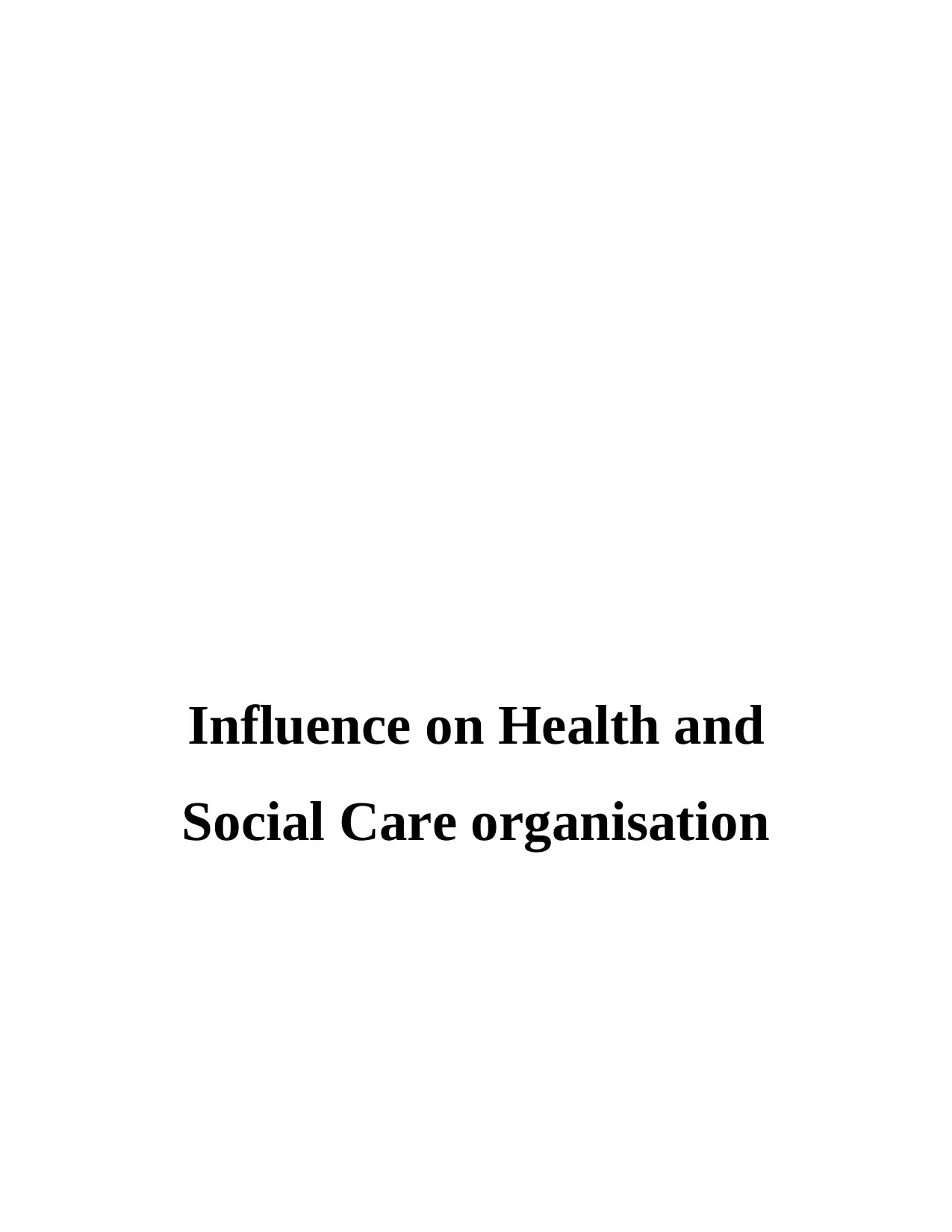
Influence on Health and
Social Care organisation
Social Care organisation
Paraphrase This Document
Need a fresh take? Get an instant paraphrase of this document with our AI Paraphraser
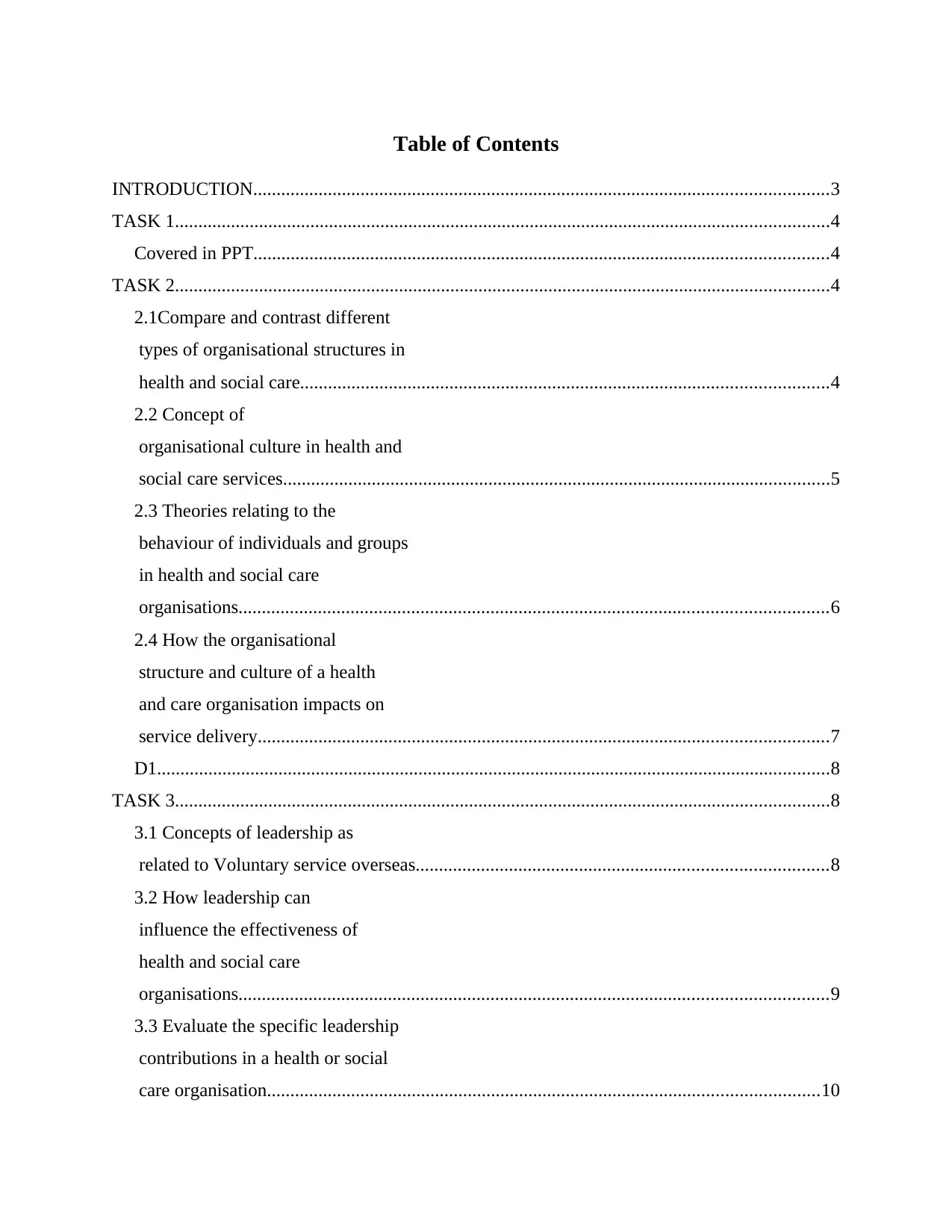
Table of Contents
INTRODUCTION...........................................................................................................................3
TASK 1............................................................................................................................................4
Covered in PPT...........................................................................................................................4
TASK 2............................................................................................................................................4
2.1Compare and contrast different
types of organisational structures in
health and social care.................................................................................................................4
2.2 Concept of
organisational culture in health and
social care services.....................................................................................................................5
2.3 Theories relating to the
behaviour of individuals and groups
in health and social care
organisations..............................................................................................................................6
2.4 How the organisational
structure and culture of a health
and care organisation impacts on
service delivery..........................................................................................................................7
D1................................................................................................................................................8
TASK 3............................................................................................................................................8
3.1 Concepts of leadership as
related to Voluntary service overseas........................................................................................8
3.2 How leadership can
influence the effectiveness of
health and social care
organisations..............................................................................................................................9
3.3 Evaluate the specific leadership
contributions in a health or social
care organisation......................................................................................................................10
INTRODUCTION...........................................................................................................................3
TASK 1............................................................................................................................................4
Covered in PPT...........................................................................................................................4
TASK 2............................................................................................................................................4
2.1Compare and contrast different
types of organisational structures in
health and social care.................................................................................................................4
2.2 Concept of
organisational culture in health and
social care services.....................................................................................................................5
2.3 Theories relating to the
behaviour of individuals and groups
in health and social care
organisations..............................................................................................................................6
2.4 How the organisational
structure and culture of a health
and care organisation impacts on
service delivery..........................................................................................................................7
D1................................................................................................................................................8
TASK 3............................................................................................................................................8
3.1 Concepts of leadership as
related to Voluntary service overseas........................................................................................8
3.2 How leadership can
influence the effectiveness of
health and social care
organisations..............................................................................................................................9
3.3 Evaluate the specific leadership
contributions in a health or social
care organisation......................................................................................................................10
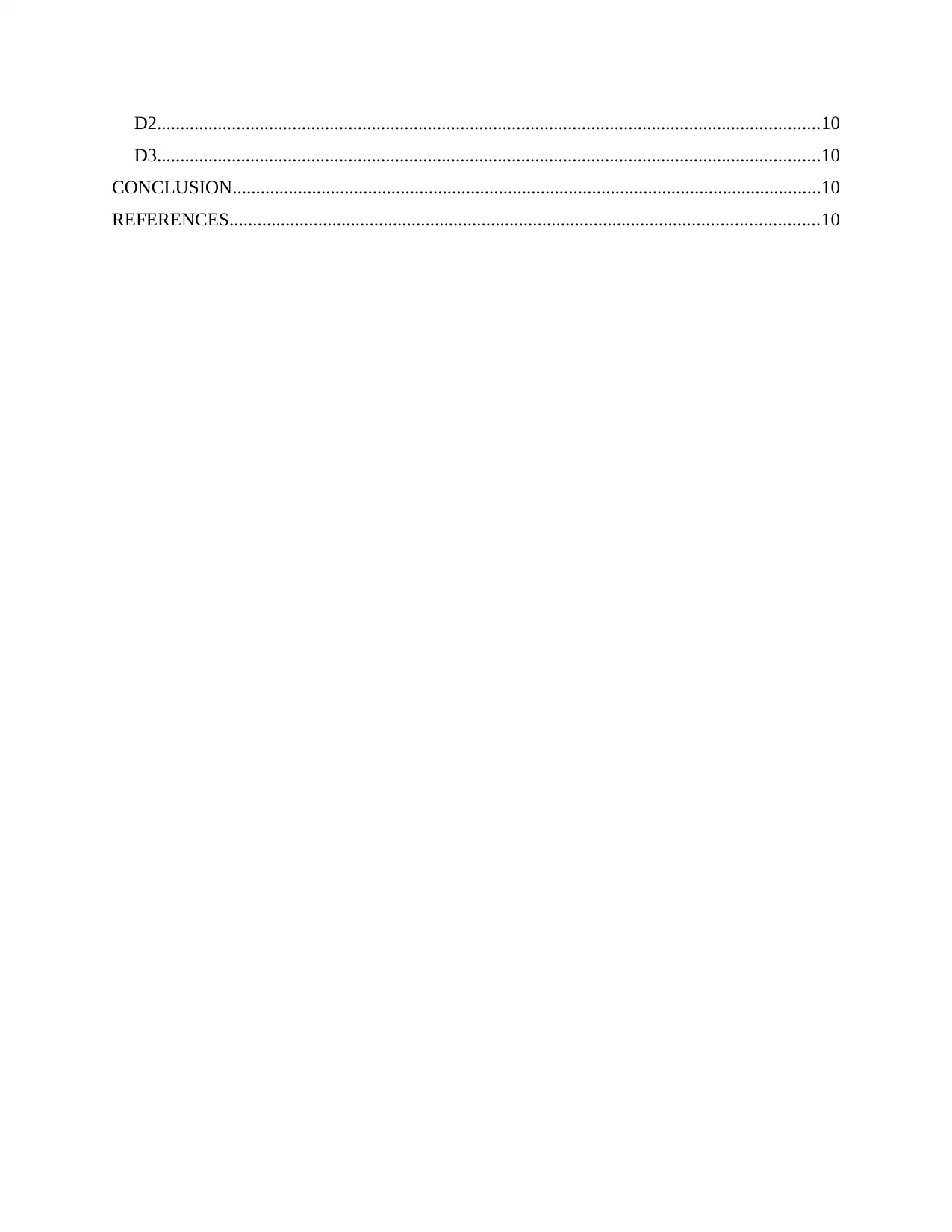
D2..............................................................................................................................................10
D3..............................................................................................................................................10
CONCLUSION..............................................................................................................................10
REFERENCES..............................................................................................................................10
D3..............................................................................................................................................10
CONCLUSION..............................................................................................................................10
REFERENCES..............................................................................................................................10
⊘ This is a preview!⊘
Do you want full access?
Subscribe today to unlock all pages.

Trusted by 1+ million students worldwide
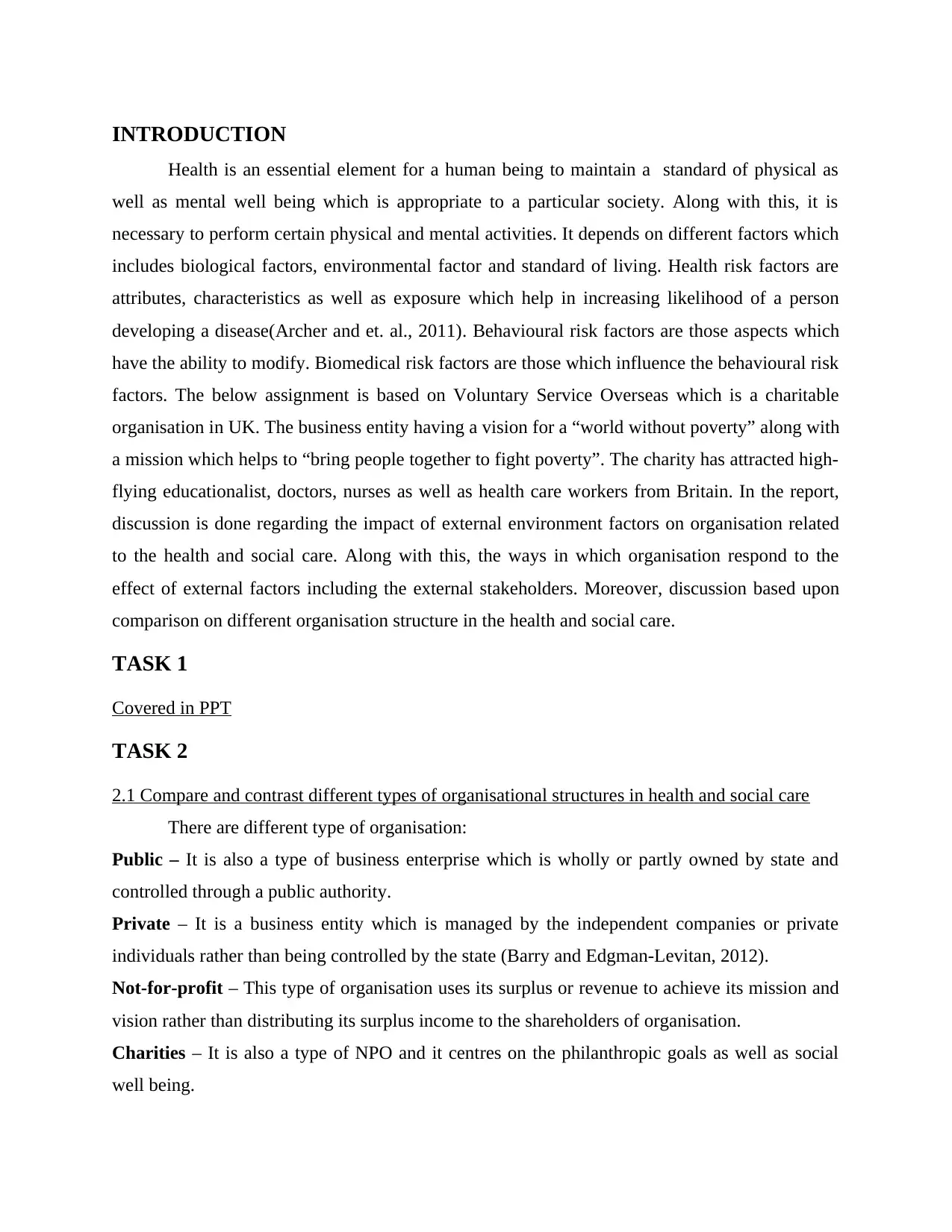
INTRODUCTION
Health is an essential element for a human being to maintain a standard of physical as
well as mental well being which is appropriate to a particular society. Along with this, it is
necessary to perform certain physical and mental activities. It depends on different factors which
includes biological factors, environmental factor and standard of living. Health risk factors are
attributes, characteristics as well as exposure which help in increasing likelihood of a person
developing a disease(Archer and et. al., 2011). Behavioural risk factors are those aspects which
have the ability to modify. Biomedical risk factors are those which influence the behavioural risk
factors. The below assignment is based on Voluntary Service Overseas which is a charitable
organisation in UK. The business entity having a vision for a “world without poverty” along with
a mission which helps to “bring people together to fight poverty”. The charity has attracted high-
flying educationalist, doctors, nurses as well as health care workers from Britain. In the report,
discussion is done regarding the impact of external environment factors on organisation related
to the health and social care. Along with this, the ways in which organisation respond to the
effect of external factors including the external stakeholders. Moreover, discussion based upon
comparison on different organisation structure in the health and social care.
TASK 1
Covered in PPT
TASK 2
2.1 Compare and contrast different types of organisational structures in health and social care
There are different type of organisation:
Public – It is also a type of business enterprise which is wholly or partly owned by state and
controlled through a public authority.
Private – It is a business entity which is managed by the independent companies or private
individuals rather than being controlled by the state (Barry and Edgman-Levitan, 2012).
Not-for-profit – This type of organisation uses its surplus or revenue to achieve its mission and
vision rather than distributing its surplus income to the shareholders of organisation.
Charities – It is also a type of NPO and it centres on the philanthropic goals as well as social
well being.
Health is an essential element for a human being to maintain a standard of physical as
well as mental well being which is appropriate to a particular society. Along with this, it is
necessary to perform certain physical and mental activities. It depends on different factors which
includes biological factors, environmental factor and standard of living. Health risk factors are
attributes, characteristics as well as exposure which help in increasing likelihood of a person
developing a disease(Archer and et. al., 2011). Behavioural risk factors are those aspects which
have the ability to modify. Biomedical risk factors are those which influence the behavioural risk
factors. The below assignment is based on Voluntary Service Overseas which is a charitable
organisation in UK. The business entity having a vision for a “world without poverty” along with
a mission which helps to “bring people together to fight poverty”. The charity has attracted high-
flying educationalist, doctors, nurses as well as health care workers from Britain. In the report,
discussion is done regarding the impact of external environment factors on organisation related
to the health and social care. Along with this, the ways in which organisation respond to the
effect of external factors including the external stakeholders. Moreover, discussion based upon
comparison on different organisation structure in the health and social care.
TASK 1
Covered in PPT
TASK 2
2.1 Compare and contrast different types of organisational structures in health and social care
There are different type of organisation:
Public – It is also a type of business enterprise which is wholly or partly owned by state and
controlled through a public authority.
Private – It is a business entity which is managed by the independent companies or private
individuals rather than being controlled by the state (Barry and Edgman-Levitan, 2012).
Not-for-profit – This type of organisation uses its surplus or revenue to achieve its mission and
vision rather than distributing its surplus income to the shareholders of organisation.
Charities – It is also a type of NPO and it centres on the philanthropic goals as well as social
well being.
Paraphrase This Document
Need a fresh take? Get an instant paraphrase of this document with our AI Paraphraser
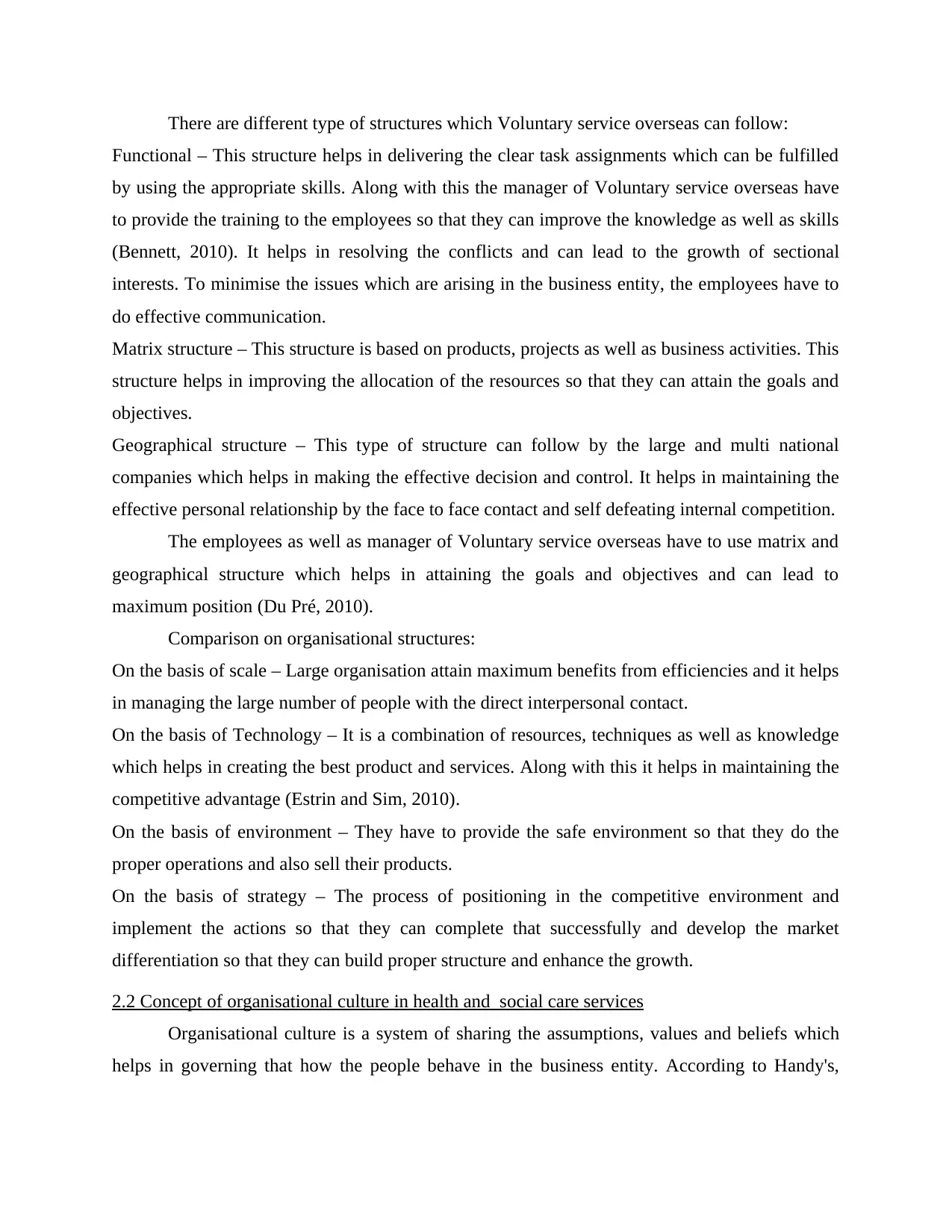
There are different type of structures which Voluntary service overseas can follow:
Functional – This structure helps in delivering the clear task assignments which can be fulfilled
by using the appropriate skills. Along with this the manager of Voluntary service overseas have
to provide the training to the employees so that they can improve the knowledge as well as skills
(Bennett, 2010). It helps in resolving the conflicts and can lead to the growth of sectional
interests. To minimise the issues which are arising in the business entity, the employees have to
do effective communication.
Matrix structure – This structure is based on products, projects as well as business activities. This
structure helps in improving the allocation of the resources so that they can attain the goals and
objectives.
Geographical structure – This type of structure can follow by the large and multi national
companies which helps in making the effective decision and control. It helps in maintaining the
effective personal relationship by the face to face contact and self defeating internal competition.
The employees as well as manager of Voluntary service overseas have to use matrix and
geographical structure which helps in attaining the goals and objectives and can lead to
maximum position (Du Pré, 2010).
Comparison on organisational structures:
On the basis of scale – Large organisation attain maximum benefits from efficiencies and it helps
in managing the large number of people with the direct interpersonal contact.
On the basis of Technology – It is a combination of resources, techniques as well as knowledge
which helps in creating the best product and services. Along with this it helps in maintaining the
competitive advantage (Estrin and Sim, 2010).
On the basis of environment – They have to provide the safe environment so that they do the
proper operations and also sell their products.
On the basis of strategy – The process of positioning in the competitive environment and
implement the actions so that they can complete that successfully and develop the market
differentiation so that they can build proper structure and enhance the growth.
2.2 Concept of organisational culture in health and social care services
Organisational culture is a system of sharing the assumptions, values and beliefs which
helps in governing that how the people behave in the business entity. According to Handy's,
Functional – This structure helps in delivering the clear task assignments which can be fulfilled
by using the appropriate skills. Along with this the manager of Voluntary service overseas have
to provide the training to the employees so that they can improve the knowledge as well as skills
(Bennett, 2010). It helps in resolving the conflicts and can lead to the growth of sectional
interests. To minimise the issues which are arising in the business entity, the employees have to
do effective communication.
Matrix structure – This structure is based on products, projects as well as business activities. This
structure helps in improving the allocation of the resources so that they can attain the goals and
objectives.
Geographical structure – This type of structure can follow by the large and multi national
companies which helps in making the effective decision and control. It helps in maintaining the
effective personal relationship by the face to face contact and self defeating internal competition.
The employees as well as manager of Voluntary service overseas have to use matrix and
geographical structure which helps in attaining the goals and objectives and can lead to
maximum position (Du Pré, 2010).
Comparison on organisational structures:
On the basis of scale – Large organisation attain maximum benefits from efficiencies and it helps
in managing the large number of people with the direct interpersonal contact.
On the basis of Technology – It is a combination of resources, techniques as well as knowledge
which helps in creating the best product and services. Along with this it helps in maintaining the
competitive advantage (Estrin and Sim, 2010).
On the basis of environment – They have to provide the safe environment so that they do the
proper operations and also sell their products.
On the basis of strategy – The process of positioning in the competitive environment and
implement the actions so that they can complete that successfully and develop the market
differentiation so that they can build proper structure and enhance the growth.
2.2 Concept of organisational culture in health and social care services
Organisational culture is a system of sharing the assumptions, values and beliefs which
helps in governing that how the people behave in the business entity. According to Handy's,
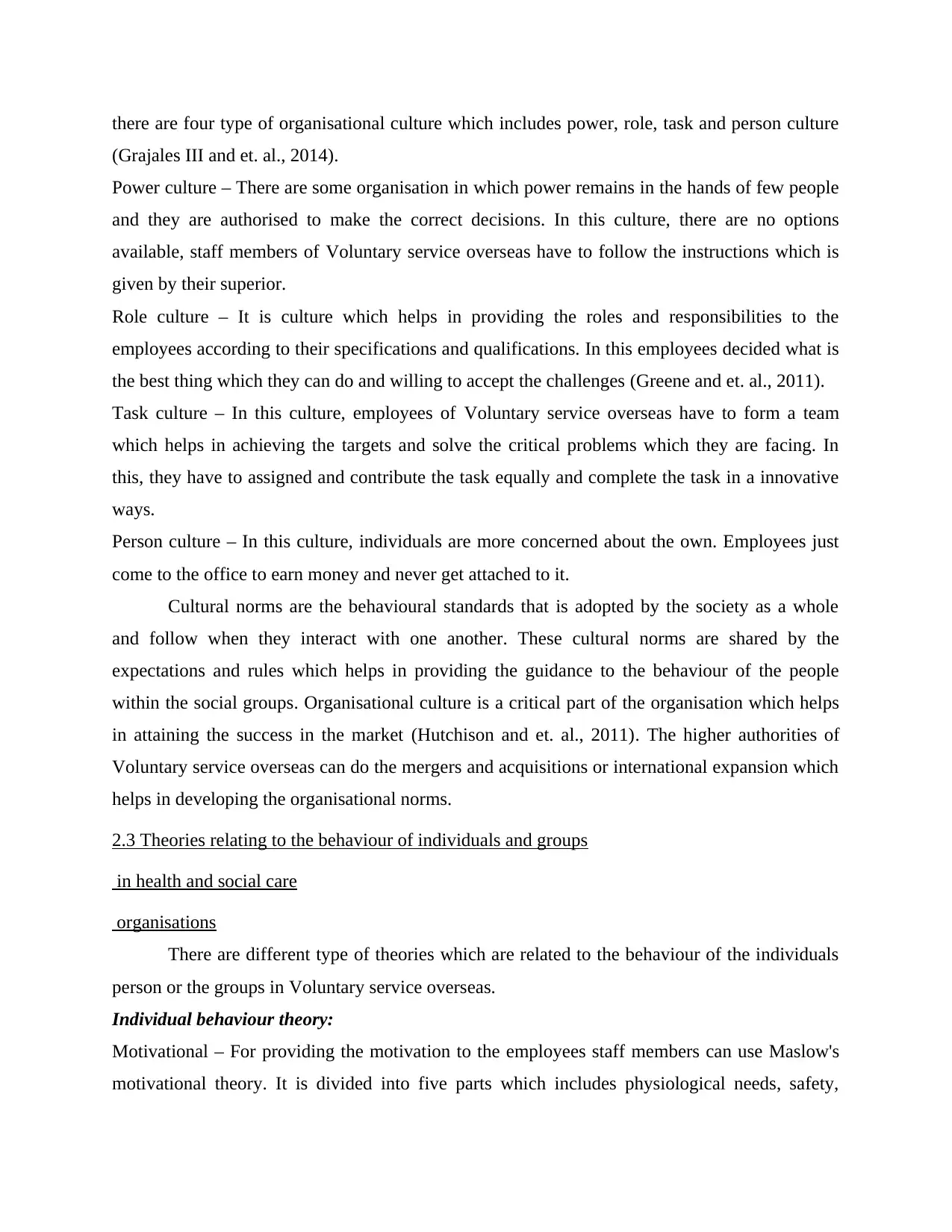
there are four type of organisational culture which includes power, role, task and person culture
(Grajales III and et. al., 2014).
Power culture – There are some organisation in which power remains in the hands of few people
and they are authorised to make the correct decisions. In this culture, there are no options
available, staff members of Voluntary service overseas have to follow the instructions which is
given by their superior.
Role culture – It is culture which helps in providing the roles and responsibilities to the
employees according to their specifications and qualifications. In this employees decided what is
the best thing which they can do and willing to accept the challenges (Greene and et. al., 2011).
Task culture – In this culture, employees of Voluntary service overseas have to form a team
which helps in achieving the targets and solve the critical problems which they are facing. In
this, they have to assigned and contribute the task equally and complete the task in a innovative
ways.
Person culture – In this culture, individuals are more concerned about the own. Employees just
come to the office to earn money and never get attached to it.
Cultural norms are the behavioural standards that is adopted by the society as a whole
and follow when they interact with one another. These cultural norms are shared by the
expectations and rules which helps in providing the guidance to the behaviour of the people
within the social groups. Organisational culture is a critical part of the organisation which helps
in attaining the success in the market (Hutchison and et. al., 2011). The higher authorities of
Voluntary service overseas can do the mergers and acquisitions or international expansion which
helps in developing the organisational norms.
2.3 Theories relating to the behaviour of individuals and groups
in health and social care
organisations
There are different type of theories which are related to the behaviour of the individuals
person or the groups in Voluntary service overseas.
Individual behaviour theory:
Motivational – For providing the motivation to the employees staff members can use Maslow's
motivational theory. It is divided into five parts which includes physiological needs, safety,
(Grajales III and et. al., 2014).
Power culture – There are some organisation in which power remains in the hands of few people
and they are authorised to make the correct decisions. In this culture, there are no options
available, staff members of Voluntary service overseas have to follow the instructions which is
given by their superior.
Role culture – It is culture which helps in providing the roles and responsibilities to the
employees according to their specifications and qualifications. In this employees decided what is
the best thing which they can do and willing to accept the challenges (Greene and et. al., 2011).
Task culture – In this culture, employees of Voluntary service overseas have to form a team
which helps in achieving the targets and solve the critical problems which they are facing. In
this, they have to assigned and contribute the task equally and complete the task in a innovative
ways.
Person culture – In this culture, individuals are more concerned about the own. Employees just
come to the office to earn money and never get attached to it.
Cultural norms are the behavioural standards that is adopted by the society as a whole
and follow when they interact with one another. These cultural norms are shared by the
expectations and rules which helps in providing the guidance to the behaviour of the people
within the social groups. Organisational culture is a critical part of the organisation which helps
in attaining the success in the market (Hutchison and et. al., 2011). The higher authorities of
Voluntary service overseas can do the mergers and acquisitions or international expansion which
helps in developing the organisational norms.
2.3 Theories relating to the behaviour of individuals and groups
in health and social care
organisations
There are different type of theories which are related to the behaviour of the individuals
person or the groups in Voluntary service overseas.
Individual behaviour theory:
Motivational – For providing the motivation to the employees staff members can use Maslow's
motivational theory. It is divided into five parts which includes physiological needs, safety,
⊘ This is a preview!⊘
Do you want full access?
Subscribe today to unlock all pages.

Trusted by 1+ million students worldwide
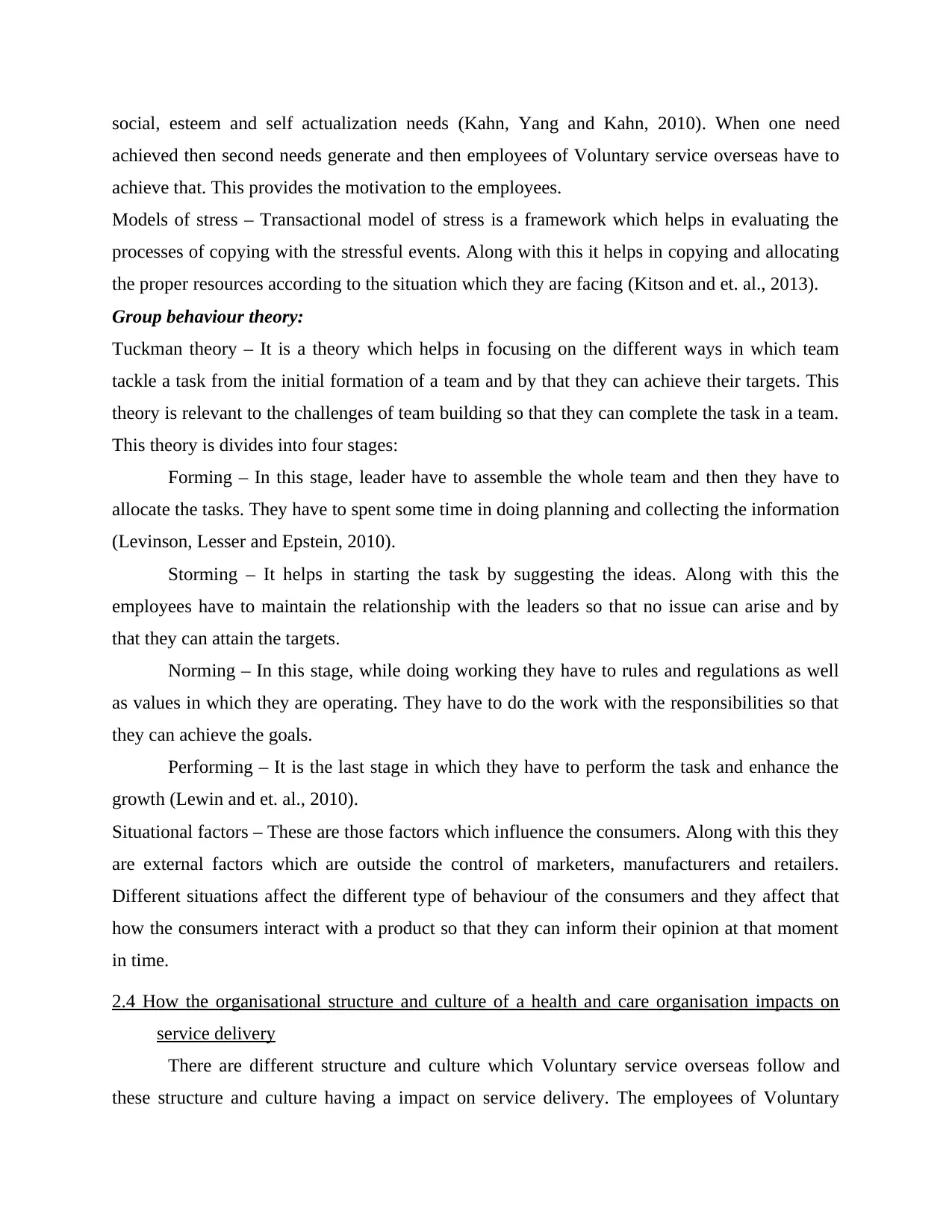
social, esteem and self actualization needs (Kahn, Yang and Kahn, 2010). When one need
achieved then second needs generate and then employees of Voluntary service overseas have to
achieve that. This provides the motivation to the employees.
Models of stress – Transactional model of stress is a framework which helps in evaluating the
processes of copying with the stressful events. Along with this it helps in copying and allocating
the proper resources according to the situation which they are facing (Kitson and et. al., 2013).
Group behaviour theory:
Tuckman theory – It is a theory which helps in focusing on the different ways in which team
tackle a task from the initial formation of a team and by that they can achieve their targets. This
theory is relevant to the challenges of team building so that they can complete the task in a team.
This theory is divides into four stages:
Forming – In this stage, leader have to assemble the whole team and then they have to
allocate the tasks. They have to spent some time in doing planning and collecting the information
(Levinson, Lesser and Epstein, 2010).
Storming – It helps in starting the task by suggesting the ideas. Along with this the
employees have to maintain the relationship with the leaders so that no issue can arise and by
that they can attain the targets.
Norming – In this stage, while doing working they have to rules and regulations as well
as values in which they are operating. They have to do the work with the responsibilities so that
they can achieve the goals.
Performing – It is the last stage in which they have to perform the task and enhance the
growth (Lewin and et. al., 2010).
Situational factors – These are those factors which influence the consumers. Along with this they
are external factors which are outside the control of marketers, manufacturers and retailers.
Different situations affect the different type of behaviour of the consumers and they affect that
how the consumers interact with a product so that they can inform their opinion at that moment
in time.
2.4 How the organisational structure and culture of a health and care organisation impacts on
service delivery
There are different structure and culture which Voluntary service overseas follow and
these structure and culture having a impact on service delivery. The employees of Voluntary
achieved then second needs generate and then employees of Voluntary service overseas have to
achieve that. This provides the motivation to the employees.
Models of stress – Transactional model of stress is a framework which helps in evaluating the
processes of copying with the stressful events. Along with this it helps in copying and allocating
the proper resources according to the situation which they are facing (Kitson and et. al., 2013).
Group behaviour theory:
Tuckman theory – It is a theory which helps in focusing on the different ways in which team
tackle a task from the initial formation of a team and by that they can achieve their targets. This
theory is relevant to the challenges of team building so that they can complete the task in a team.
This theory is divides into four stages:
Forming – In this stage, leader have to assemble the whole team and then they have to
allocate the tasks. They have to spent some time in doing planning and collecting the information
(Levinson, Lesser and Epstein, 2010).
Storming – It helps in starting the task by suggesting the ideas. Along with this the
employees have to maintain the relationship with the leaders so that no issue can arise and by
that they can attain the targets.
Norming – In this stage, while doing working they have to rules and regulations as well
as values in which they are operating. They have to do the work with the responsibilities so that
they can achieve the goals.
Performing – It is the last stage in which they have to perform the task and enhance the
growth (Lewin and et. al., 2010).
Situational factors – These are those factors which influence the consumers. Along with this they
are external factors which are outside the control of marketers, manufacturers and retailers.
Different situations affect the different type of behaviour of the consumers and they affect that
how the consumers interact with a product so that they can inform their opinion at that moment
in time.
2.4 How the organisational structure and culture of a health and care organisation impacts on
service delivery
There are different structure and culture which Voluntary service overseas follow and
these structure and culture having a impact on service delivery. The employees of Voluntary
Paraphrase This Document
Need a fresh take? Get an instant paraphrase of this document with our AI Paraphraser
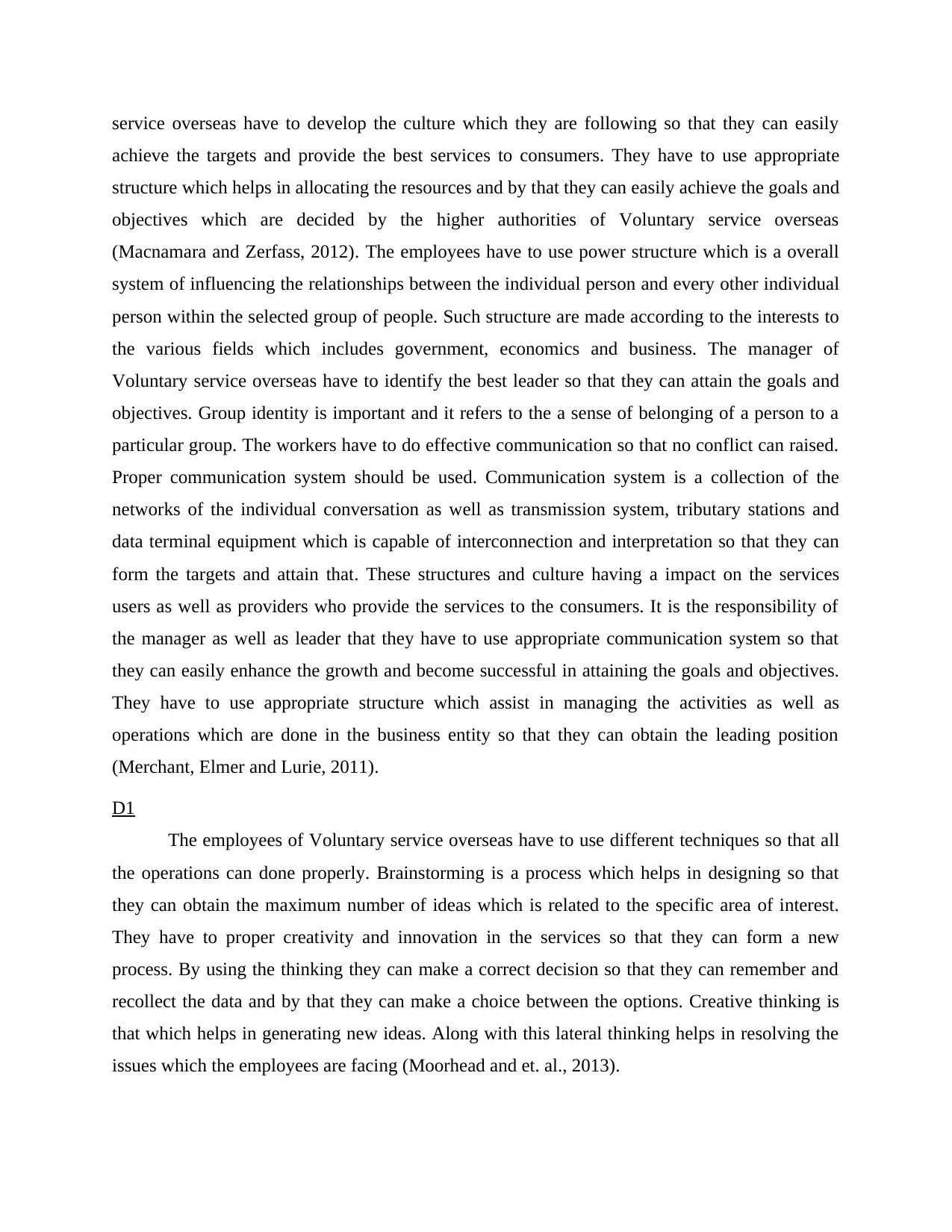
service overseas have to develop the culture which they are following so that they can easily
achieve the targets and provide the best services to consumers. They have to use appropriate
structure which helps in allocating the resources and by that they can easily achieve the goals and
objectives which are decided by the higher authorities of Voluntary service overseas
(Macnamara and Zerfass, 2012). The employees have to use power structure which is a overall
system of influencing the relationships between the individual person and every other individual
person within the selected group of people. Such structure are made according to the interests to
the various fields which includes government, economics and business. The manager of
Voluntary service overseas have to identify the best leader so that they can attain the goals and
objectives. Group identity is important and it refers to the a sense of belonging of a person to a
particular group. The workers have to do effective communication so that no conflict can raised.
Proper communication system should be used. Communication system is a collection of the
networks of the individual conversation as well as transmission system, tributary stations and
data terminal equipment which is capable of interconnection and interpretation so that they can
form the targets and attain that. These structures and culture having a impact on the services
users as well as providers who provide the services to the consumers. It is the responsibility of
the manager as well as leader that they have to use appropriate communication system so that
they can easily enhance the growth and become successful in attaining the goals and objectives.
They have to use appropriate structure which assist in managing the activities as well as
operations which are done in the business entity so that they can obtain the leading position
(Merchant, Elmer and Lurie, 2011).
D1
The employees of Voluntary service overseas have to use different techniques so that all
the operations can done properly. Brainstorming is a process which helps in designing so that
they can obtain the maximum number of ideas which is related to the specific area of interest.
They have to proper creativity and innovation in the services so that they can form a new
process. By using the thinking they can make a correct decision so that they can remember and
recollect the data and by that they can make a choice between the options. Creative thinking is
that which helps in generating new ideas. Along with this lateral thinking helps in resolving the
issues which the employees are facing (Moorhead and et. al., 2013).
achieve the targets and provide the best services to consumers. They have to use appropriate
structure which helps in allocating the resources and by that they can easily achieve the goals and
objectives which are decided by the higher authorities of Voluntary service overseas
(Macnamara and Zerfass, 2012). The employees have to use power structure which is a overall
system of influencing the relationships between the individual person and every other individual
person within the selected group of people. Such structure are made according to the interests to
the various fields which includes government, economics and business. The manager of
Voluntary service overseas have to identify the best leader so that they can attain the goals and
objectives. Group identity is important and it refers to the a sense of belonging of a person to a
particular group. The workers have to do effective communication so that no conflict can raised.
Proper communication system should be used. Communication system is a collection of the
networks of the individual conversation as well as transmission system, tributary stations and
data terminal equipment which is capable of interconnection and interpretation so that they can
form the targets and attain that. These structures and culture having a impact on the services
users as well as providers who provide the services to the consumers. It is the responsibility of
the manager as well as leader that they have to use appropriate communication system so that
they can easily enhance the growth and become successful in attaining the goals and objectives.
They have to use appropriate structure which assist in managing the activities as well as
operations which are done in the business entity so that they can obtain the leading position
(Merchant, Elmer and Lurie, 2011).
D1
The employees of Voluntary service overseas have to use different techniques so that all
the operations can done properly. Brainstorming is a process which helps in designing so that
they can obtain the maximum number of ideas which is related to the specific area of interest.
They have to proper creativity and innovation in the services so that they can form a new
process. By using the thinking they can make a correct decision so that they can remember and
recollect the data and by that they can make a choice between the options. Creative thinking is
that which helps in generating new ideas. Along with this lateral thinking helps in resolving the
issues which the employees are facing (Moorhead and et. al., 2013).
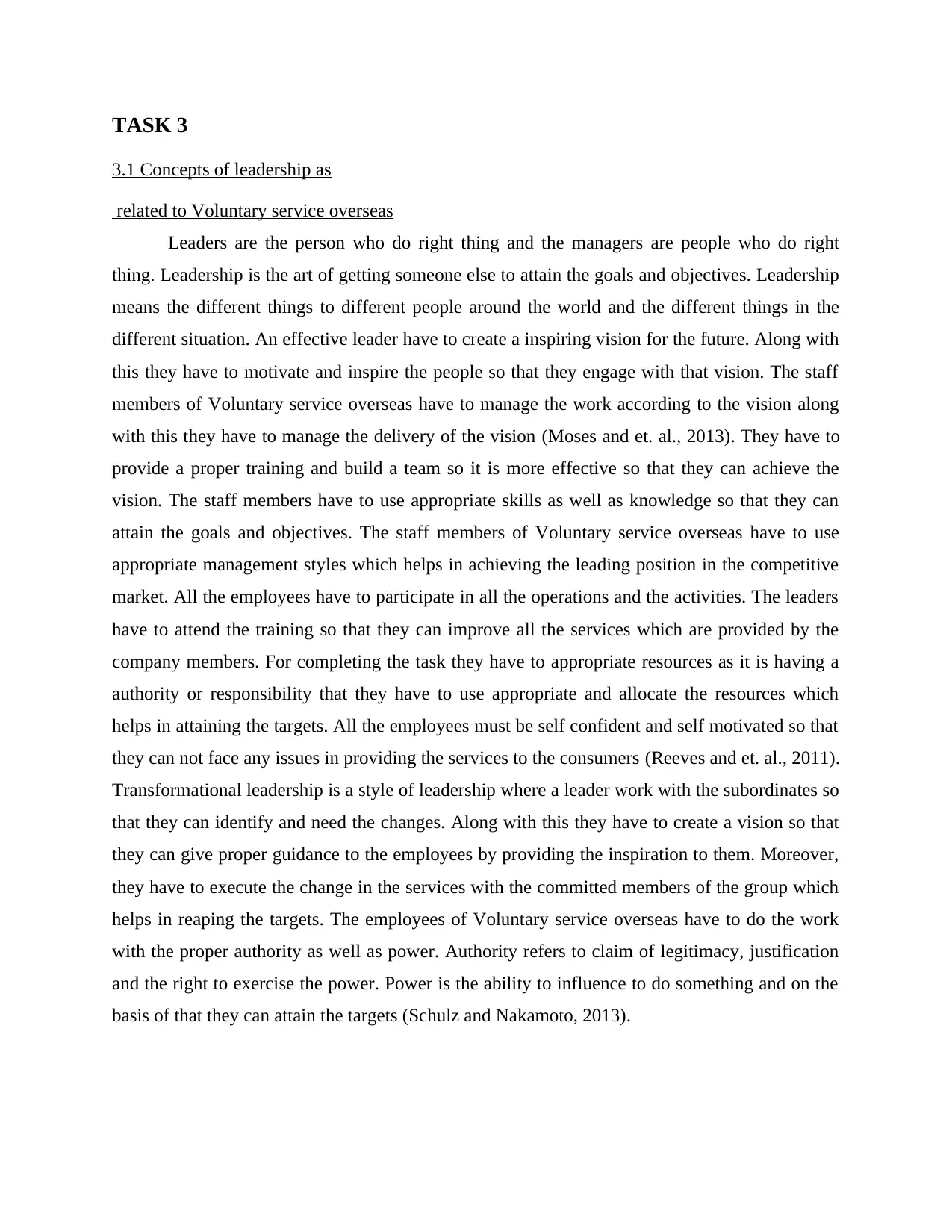
TASK 3
3.1 Concepts of leadership as
related to Voluntary service overseas
Leaders are the person who do right thing and the managers are people who do right
thing. Leadership is the art of getting someone else to attain the goals and objectives. Leadership
means the different things to different people around the world and the different things in the
different situation. An effective leader have to create a inspiring vision for the future. Along with
this they have to motivate and inspire the people so that they engage with that vision. The staff
members of Voluntary service overseas have to manage the work according to the vision along
with this they have to manage the delivery of the vision (Moses and et. al., 2013). They have to
provide a proper training and build a team so it is more effective so that they can achieve the
vision. The staff members have to use appropriate skills as well as knowledge so that they can
attain the goals and objectives. The staff members of Voluntary service overseas have to use
appropriate management styles which helps in achieving the leading position in the competitive
market. All the employees have to participate in all the operations and the activities. The leaders
have to attend the training so that they can improve all the services which are provided by the
company members. For completing the task they have to appropriate resources as it is having a
authority or responsibility that they have to use appropriate and allocate the resources which
helps in attaining the targets. All the employees must be self confident and self motivated so that
they can not face any issues in providing the services to the consumers (Reeves and et. al., 2011).
Transformational leadership is a style of leadership where a leader work with the subordinates so
that they can identify and need the changes. Along with this they have to create a vision so that
they can give proper guidance to the employees by providing the inspiration to them. Moreover,
they have to execute the change in the services with the committed members of the group which
helps in reaping the targets. The employees of Voluntary service overseas have to do the work
with the proper authority as well as power. Authority refers to claim of legitimacy, justification
and the right to exercise the power. Power is the ability to influence to do something and on the
basis of that they can attain the targets (Schulz and Nakamoto, 2013).
3.1 Concepts of leadership as
related to Voluntary service overseas
Leaders are the person who do right thing and the managers are people who do right
thing. Leadership is the art of getting someone else to attain the goals and objectives. Leadership
means the different things to different people around the world and the different things in the
different situation. An effective leader have to create a inspiring vision for the future. Along with
this they have to motivate and inspire the people so that they engage with that vision. The staff
members of Voluntary service overseas have to manage the work according to the vision along
with this they have to manage the delivery of the vision (Moses and et. al., 2013). They have to
provide a proper training and build a team so it is more effective so that they can achieve the
vision. The staff members have to use appropriate skills as well as knowledge so that they can
attain the goals and objectives. The staff members of Voluntary service overseas have to use
appropriate management styles which helps in achieving the leading position in the competitive
market. All the employees have to participate in all the operations and the activities. The leaders
have to attend the training so that they can improve all the services which are provided by the
company members. For completing the task they have to appropriate resources as it is having a
authority or responsibility that they have to use appropriate and allocate the resources which
helps in attaining the targets. All the employees must be self confident and self motivated so that
they can not face any issues in providing the services to the consumers (Reeves and et. al., 2011).
Transformational leadership is a style of leadership where a leader work with the subordinates so
that they can identify and need the changes. Along with this they have to create a vision so that
they can give proper guidance to the employees by providing the inspiration to them. Moreover,
they have to execute the change in the services with the committed members of the group which
helps in reaping the targets. The employees of Voluntary service overseas have to do the work
with the proper authority as well as power. Authority refers to claim of legitimacy, justification
and the right to exercise the power. Power is the ability to influence to do something and on the
basis of that they can attain the targets (Schulz and Nakamoto, 2013).
⊘ This is a preview!⊘
Do you want full access?
Subscribe today to unlock all pages.

Trusted by 1+ million students worldwide
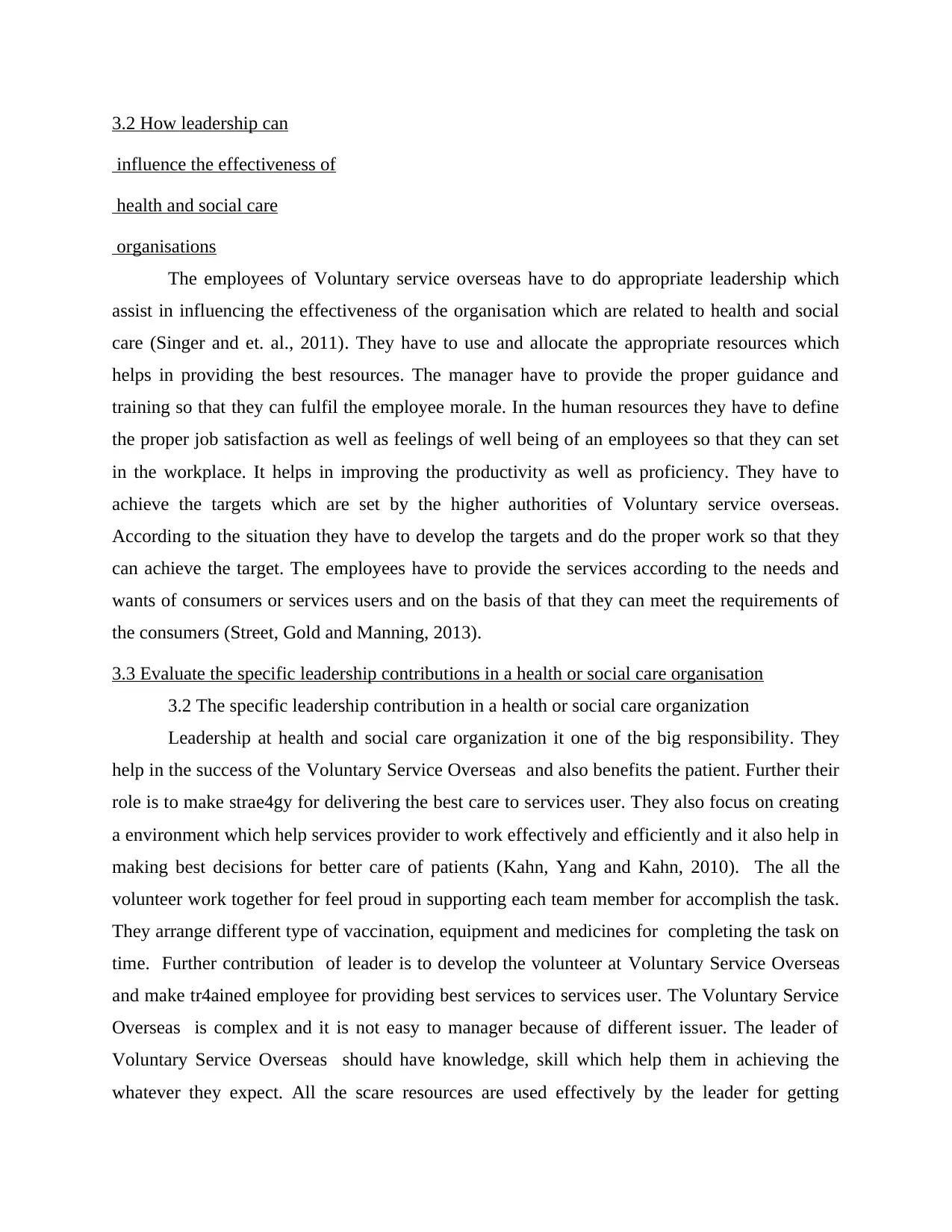
3.2 How leadership can
influence the effectiveness of
health and social care
organisations
The employees of Voluntary service overseas have to do appropriate leadership which
assist in influencing the effectiveness of the organisation which are related to health and social
care (Singer and et. al., 2011). They have to use and allocate the appropriate resources which
helps in providing the best resources. The manager have to provide the proper guidance and
training so that they can fulfil the employee morale. In the human resources they have to define
the proper job satisfaction as well as feelings of well being of an employees so that they can set
in the workplace. It helps in improving the productivity as well as proficiency. They have to
achieve the targets which are set by the higher authorities of Voluntary service overseas.
According to the situation they have to develop the targets and do the proper work so that they
can achieve the target. The employees have to provide the services according to the needs and
wants of consumers or services users and on the basis of that they can meet the requirements of
the consumers (Street, Gold and Manning, 2013).
3.3 Evaluate the specific leadership contributions in a health or social care organisation
3.2 The specific leadership contribution in a health or social care organization
Leadership at health and social care organization it one of the big responsibility. They
help in the success of the Voluntary Service Overseas and also benefits the patient. Further their
role is to make strae4gy for delivering the best care to services user. They also focus on creating
a environment which help services provider to work effectively and efficiently and it also help in
making best decisions for better care of patients (Kahn, Yang and Kahn, 2010). The all the
volunteer work together for feel proud in supporting each team member for accomplish the task.
They arrange different type of vaccination, equipment and medicines for completing the task on
time. Further contribution of leader is to develop the volunteer at Voluntary Service Overseas
and make tr4ained employee for providing best services to services user. The Voluntary Service
Overseas is complex and it is not easy to manager because of different issuer. The leader of
Voluntary Service Overseas should have knowledge, skill which help them in achieving the
whatever they expect. All the scare resources are used effectively by the leader for getting
influence the effectiveness of
health and social care
organisations
The employees of Voluntary service overseas have to do appropriate leadership which
assist in influencing the effectiveness of the organisation which are related to health and social
care (Singer and et. al., 2011). They have to use and allocate the appropriate resources which
helps in providing the best resources. The manager have to provide the proper guidance and
training so that they can fulfil the employee morale. In the human resources they have to define
the proper job satisfaction as well as feelings of well being of an employees so that they can set
in the workplace. It helps in improving the productivity as well as proficiency. They have to
achieve the targets which are set by the higher authorities of Voluntary service overseas.
According to the situation they have to develop the targets and do the proper work so that they
can achieve the target. The employees have to provide the services according to the needs and
wants of consumers or services users and on the basis of that they can meet the requirements of
the consumers (Street, Gold and Manning, 2013).
3.3 Evaluate the specific leadership contributions in a health or social care organisation
3.2 The specific leadership contribution in a health or social care organization
Leadership at health and social care organization it one of the big responsibility. They
help in the success of the Voluntary Service Overseas and also benefits the patient. Further their
role is to make strae4gy for delivering the best care to services user. They also focus on creating
a environment which help services provider to work effectively and efficiently and it also help in
making best decisions for better care of patients (Kahn, Yang and Kahn, 2010). The all the
volunteer work together for feel proud in supporting each team member for accomplish the task.
They arrange different type of vaccination, equipment and medicines for completing the task on
time. Further contribution of leader is to develop the volunteer at Voluntary Service Overseas
and make tr4ained employee for providing best services to services user. The Voluntary Service
Overseas is complex and it is not easy to manager because of different issuer. The leader of
Voluntary Service Overseas should have knowledge, skill which help them in achieving the
whatever they expect. All the scare resources are used effectively by the leader for getting
Paraphrase This Document
Need a fresh take? Get an instant paraphrase of this document with our AI Paraphraser
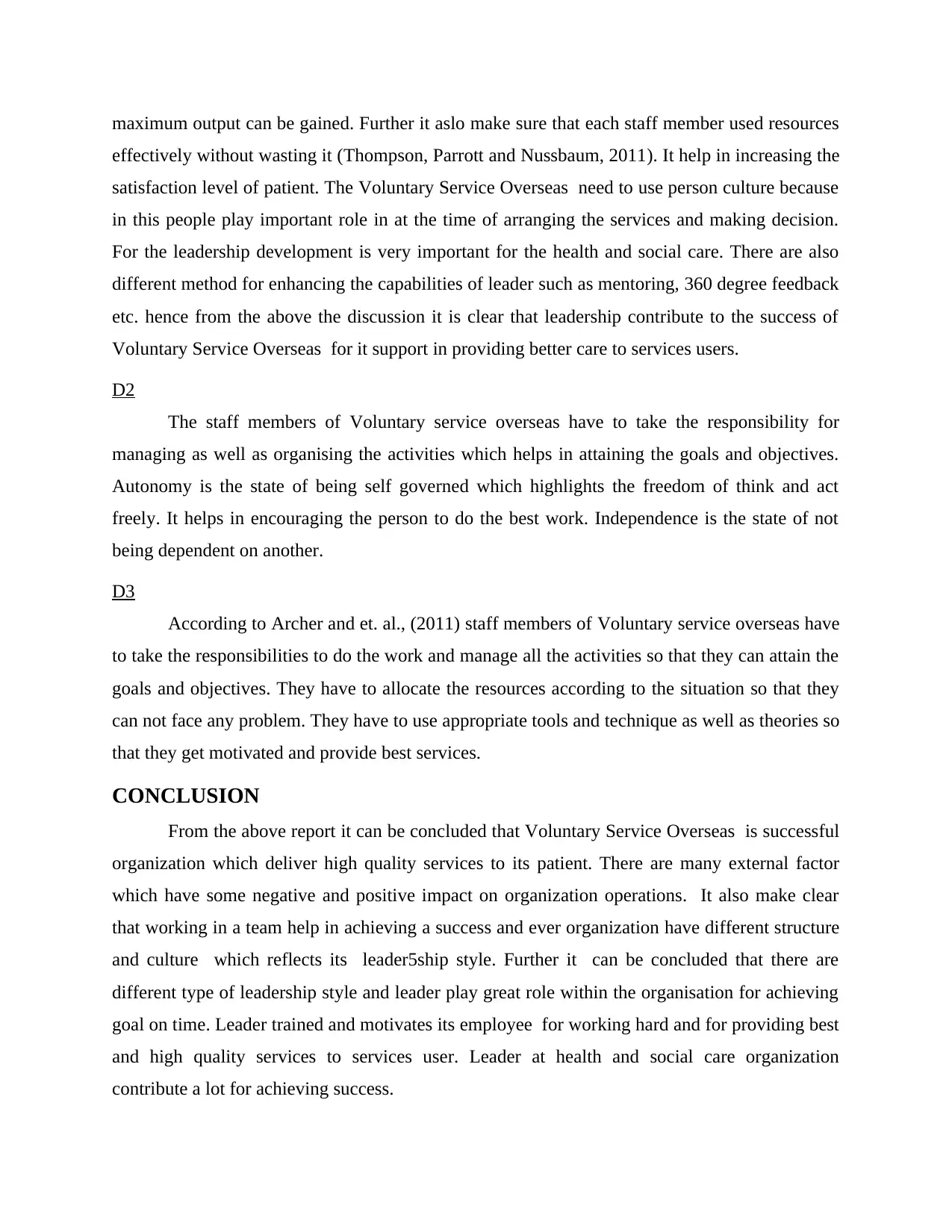
maximum output can be gained. Further it aslo make sure that each staff member used resources
effectively without wasting it (Thompson, Parrott and Nussbaum, 2011). It help in increasing the
satisfaction level of patient. The Voluntary Service Overseas need to use person culture because
in this people play important role in at the time of arranging the services and making decision.
For the leadership development is very important for the health and social care. There are also
different method for enhancing the capabilities of leader such as mentoring, 360 degree feedback
etc. hence from the above the discussion it is clear that leadership contribute to the success of
Voluntary Service Overseas for it support in providing better care to services users.
D2
The staff members of Voluntary service overseas have to take the responsibility for
managing as well as organising the activities which helps in attaining the goals and objectives.
Autonomy is the state of being self governed which highlights the freedom of think and act
freely. It helps in encouraging the person to do the best work. Independence is the state of not
being dependent on another.
D3
According to Archer and et. al., (2011) staff members of Voluntary service overseas have
to take the responsibilities to do the work and manage all the activities so that they can attain the
goals and objectives. They have to allocate the resources according to the situation so that they
can not face any problem. They have to use appropriate tools and technique as well as theories so
that they get motivated and provide best services.
CONCLUSION
From the above report it can be concluded that Voluntary Service Overseas is successful
organization which deliver high quality services to its patient. There are many external factor
which have some negative and positive impact on organization operations. It also make clear
that working in a team help in achieving a success and ever organization have different structure
and culture which reflects its leader5ship style. Further it can be concluded that there are
different type of leadership style and leader play great role within the organisation for achieving
goal on time. Leader trained and motivates its employee for working hard and for providing best
and high quality services to services user. Leader at health and social care organization
contribute a lot for achieving success.
effectively without wasting it (Thompson, Parrott and Nussbaum, 2011). It help in increasing the
satisfaction level of patient. The Voluntary Service Overseas need to use person culture because
in this people play important role in at the time of arranging the services and making decision.
For the leadership development is very important for the health and social care. There are also
different method for enhancing the capabilities of leader such as mentoring, 360 degree feedback
etc. hence from the above the discussion it is clear that leadership contribute to the success of
Voluntary Service Overseas for it support in providing better care to services users.
D2
The staff members of Voluntary service overseas have to take the responsibility for
managing as well as organising the activities which helps in attaining the goals and objectives.
Autonomy is the state of being self governed which highlights the freedom of think and act
freely. It helps in encouraging the person to do the best work. Independence is the state of not
being dependent on another.
D3
According to Archer and et. al., (2011) staff members of Voluntary service overseas have
to take the responsibilities to do the work and manage all the activities so that they can attain the
goals and objectives. They have to allocate the resources according to the situation so that they
can not face any problem. They have to use appropriate tools and technique as well as theories so
that they get motivated and provide best services.
CONCLUSION
From the above report it can be concluded that Voluntary Service Overseas is successful
organization which deliver high quality services to its patient. There are many external factor
which have some negative and positive impact on organization operations. It also make clear
that working in a team help in achieving a success and ever organization have different structure
and culture which reflects its leader5ship style. Further it can be concluded that there are
different type of leadership style and leader play great role within the organisation for achieving
goal on time. Leader trained and motivates its employee for working hard and for providing best
and high quality services to services user. Leader at health and social care organization
contribute a lot for achieving success.

⊘ This is a preview!⊘
Do you want full access?
Subscribe today to unlock all pages.

Trusted by 1+ million students worldwide
1 out of 14
Related Documents
Your All-in-One AI-Powered Toolkit for Academic Success.
+13062052269
info@desklib.com
Available 24*7 on WhatsApp / Email
![[object Object]](/_next/static/media/star-bottom.7253800d.svg)
Unlock your academic potential
Copyright © 2020–2025 A2Z Services. All Rights Reserved. Developed and managed by ZUCOL.





